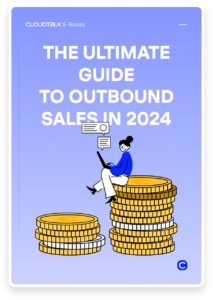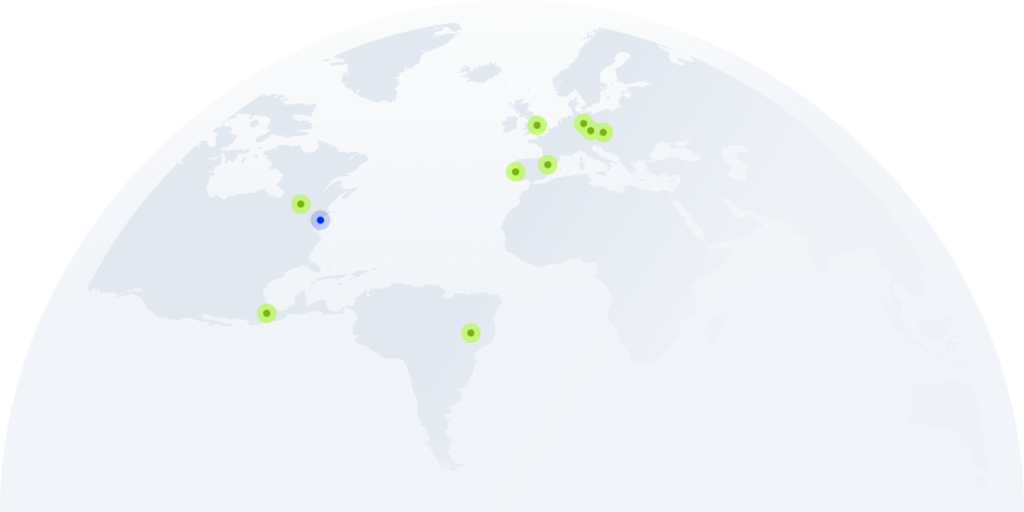Exploit the Power of Automated Outbound Calling

Automated outbound calls have changed the way companies engage with customers, prospects, and stakeholders. Sales reps make an average of 52 calls per day. Can you imagine the efficiency and productivity gains your company could achieve with automated calls?
Key Takeaways:
- Learn how to increase call volume, personalize messages, reduce costs, prioritize valuable leads, and ensure consistent communication with automated outbound calling
- The focus lies on smart dialers, AI personalization, analytics, compliance, and a user-friendly interface for efficiency and easy adaptation.
- Be mindful of potential drawbacks when implementing automated outbound calling, such as the risk of annoying customers or cost considerations.
- Maximize the success of your automated outbound calling by accurately segmenting your audience, customizing communications, adhering to suitable calling times, analyzing call performance, and continuously refining strategies based on feedback.
What Is Automated Outbound Calling?
Automated systems are essential for the modernization of corporate communications, offering a more efficient way to conduct outreach and follow-ups.
The automated outbound calling dials numbers from a predefined contact list. When a call is answered, the system can either play a recorded message or connect the call to a live agent.
Especially with the help of AI, you can see a 30-50% increase in efficiency, highlighting its impact on optimizing operations.
How Automated Outbound Calling Works
The software is usually equipped to handle multiple calls simultaneously, thus reducing wait times and maximizing productivity. The agents are able to handle a higher volume of calls and can initiate calls directly from a CRM.
Advanced automated dialers can skip voicemails or busy signals, immediately moving to the next call.
There are different types of dialers, serving different functions:
1. Auto Dialer
Auto Dialers are an umbrella term for hardware and software systems that allow users to make calls without needing to manually dial phone numbers.
Benefits:
- Automates mass outreach by calling from a predefined list, streamlining the process;
- Saves time and effort by eliminating manual dialing, allowing more focus on the conversation;
- Enhances lead generation and contact reach efficiency for teams or individuals.
Works best for: Low-cost, high-volume call campaigns.
Learn more about Auto Dialer.
2. Power Dialer
Multi-line sales dialer to help you reach 3x more leads by calling multiple contacts at once.
Benefits:
- Streamline agents’ daily tasks with pre-made campaigns, scripts, etc.;
- Save time by automatically dialing a new number at the end of a call;
- Power analytics with on-call tagging, note-taking, etc.;
Works best for: High-volume call campaigns.
Learn more about Power Dialer.
3. Predictive Dialer
Sometimes, it can boost successful calls by <400%.
Benefits:
- Utilizes advanced algorithms to dial multiple numbers simultaneously, only connecting agents to live responses;
- Maximizes calling efficiency by significantly reducing agent idle time;
- Optimizes high-volume calling strategies by ensuring continuous engagement with minimal downtime.
Works best for: High-volume call campaigns with limited resources.
Learn more about Predictive Dialer.
Practical Use Cases of Automated Outbound Calling
Imagine being able to reach out to your customers not just en masse but with messages so tailored and timely they feel personally crafted.
Automated outbound calling gives you the ability to speak directly to your customers, but with a level of efficiency and personalization that traditional methods can’t match.
The software can be used for the following tasks, among others:
- Product Launches: Announce your latest offerings with calls that not only inform but also invite feedback, creating a dialogue that enhances customer interest and engagement.
- Special Promotions: Use targeted calls to share exclusive deals or discounts, making each customer feel valued and increasing the likelihood of conversion.
- Lead Nurturing: Follow up on leads with personalized messages based on their previous interactions with your brand, showing you’re attentive and ready to meet their needs.
- Appointment Reminders: Send reminders for upcoming appointments or events, reducing no-shows and reinforcing the importance of their participation.
- Customer Surveys: Collect valuable feedback directly from your customers through automated calls, providing insights into their satisfaction and areas for improvement.
Especially AI-driven outbound calling can work like a game changer for your business because the technology constantly learns and adapts and can be used for:
- Dynamic Conversations: AI can analyze responses in real time, tailoring the conversation flow based on customer reactions. This ensures that each call is relevant and engaging for the recipient.
- Predictive Timing: By analyzing customer data, AI predicts the most effective times to reach out, ensuring your calls are more likely to be answered and engaged with.
- Enhanced Personalization: AI-driven software can segment your audience based on various criteria, allowing for highly personalized messaging that resonates with each group’s unique preferences and behaviors.
The Benefits of Automated Outbound Calling
Embracing automated outbound calling propels your business operations and customer engagement to new heights with several transformative benefits:
1. Increase Efficiency
Imagine your business making a leap in productivity. Automated outbound calling can now accelerate the dialing process because it reduces the idle time for your agents who can then reach more contacts efficiently.
2. Tailor Your Communications
Advanced analytics improve communication with the customer by predicting behavior, identifying buying patterns, and optimizing contact times. This increases satisfaction and customer loyalty through personalized communication.
3. Achieve Cost Efficiency Through Smart Deployment
Automated calls streamline workflows and lower operating costs, from labor reduction to minimizing fixed costs. Scalability ensures optimal use of resources and increases ROI.
4. Optimize Lead Conversion Through Strategic Prioritization
Automated systems improve lead management by evaluating and prioritizing potential customers. This enables a targeted approach that improves conversion rates and marketing efficiency.
5. Uphold Brand Integrity with Consistent Communication
Automated calling guarantees brand voice consistency across all touchpoints, vital for building trust and recognition. Automated outbound calling ensures that each message delivered aligns with your brand’s standards and messaging framework.
6. Expand Reach with Multilingual Capabilities
Modern automated calling systems often include multilingual capabilities, allowing messages to be delivered in the preferred language of the recipient. This feature is useful for expanding your reach.
CloutTalk for example offers 160 international numbers and the AI-supported software enables transcriptions in 145 languages.
Automated Outbound Calling Drawbacks to Keep in Mind
When integrating automated outbound calling into your business, it’s important to be aware of potential challenges and considerations that could arise. What you have to look out for is:
- Annoyed Customer: Strategically plan your calling campaigns to target the right audience with relevant messages that enhance customer satisfaction and loyalty. Avoid irrelevant calls and protect your brand’s reputation.
- Technical Issues: Choose a system with robust support and maintenance that minimizes downtimes. Ensure your communication strategy remains uninterrupted.
- Compliance Risks: Your practices must comply with regulations such as GDPR in Europe and TCPA in the United States. It’s crucial to stay informed and aligned with these laws to maintain the integrity of your telemarketing efforts.
- Lack of Personal Touch: Balance automation with human interaction. Integrate personalized elements in automated calls.
- Cost Overheads: Understanding the financial implications is vital for your budget planning. Manage costs by evaluating the ROI and consider scalable solutions while still leveraging the benefits of automated calling.
- Training Requirements: Equip your staff with the necessary skills. Investing in thorough training ensures your team can maximize the system’s capabilities.
6 Best Practices for Automated Outbound Calling
The best practices for automated outbound calling should align with your business goals. These key insights will assist you in maximizing the impact of your automated calling initiatives.
1. Target Appropriately
Ensuring that your call list is well-segmented will significantly increase the relevance of your calls. This increases engagement rates and reduces the likelihood of prospects becoming annoyed or frustrated.
2. Personalize Calls
Leveraging available data to tailor your messages creates a more meaningful connection with each recipient, improving customer engagement and response rates. It also shows your brand’s commitment to understanding and valuing its customers.
3. Respect Timing
Adhering to appropriate calling times not only respects your customers’ boundaries but also increases the chances of your calls being well-received. Studies suggest that mid-to-late afternoon, especially Wednesdays and Thursdays, are optimal.
4. Monitor Performance
Regularly analyzing the outcomes of your calls, allows you to identify trends, pinpoint areas for improvement, and adapt your strategies to enhance the success of your calling campaigns, ultimately driving better results.
5. Ensure Compliance
Staying abreast of and adhering to relevant laws and regulations is crucial to maintaining your business’s integrity and avoiding potential legal repercussions. This protects your brand reputation and ensures the longevity of your outreach efforts.
6. Feedback Loop
Encouraging and incorporating feedback from your team offers invaluable insights that lead to continuous improvement of your call strategies, fostering a culture of learning and adaptation that enhances the effectiveness of your outreach efforts.
Key Features to Look for in Automated Outbound Calling Solutions
When scouting for automated outbound calling solutions, pinpointing the right features is pivotal for aligning with your business goals. Here’s a deeper look into essential features, including insights on pricing and scalability, to guide your selection process:
- Advanced Personalization and Segmentation
Personalization increases the effectiveness of your calls. Look for systems that offer dynamic scripting and allow for segmenting your audience based on behavior, preferences, or purchase history, enabling more targeted and meaningful conversations.
Select a solution that offer AI capabilities to tailor calls based on the information you already gained from your customer or prospect.
Solutions should allow for easy adjustment as your target audience grows or diversifies, without compromising on personalization quality.
- Robust Compliance Management
With regulations like GDPR and TCPA setting strict guidelines for customer outreach, your chosen solution must have solid compliance management features, safeguarding your business and customers. This includes consent tracking, do-not-call list management, and customizable calling schedules to adhere to time zone restrictions.
While essential, ensure that compliance features don’t disproportionately inflate costs. Look for a balanced solution that offers robust compliance tools as part of its core offering.
- Intelligent Call Routing and Response Analysis
Efficiently connecting customers with the most appropriate agent or providing timely responses based on AI analysis can significantly improve customer experience and operational efficiency.
The system should intelligently adapt to varying call volumes and customer needs, ensuring high-quality interactions regardless of business size.
- Real-Time Analytics and Reporting
Access to detailed reports and analytics allows you to measure the success of your campaigns, make data-driven decisions, and continuously optimize your strategies.
Opt for solutions that provide comprehensive analytics without requiring expensive upgrades. As your data needs grow, the platform should offer deeper insights without a steep price hike.
How to Choose the Right Automated Outbound Calling Solution
While choosing the right solution, focus on the perfect blend of cost-effectiveness, scalability, industry fit, seamless integration, and reliability.
Let’s walk through a tailored approach to finding that perfect match for your business.
1. Step: Understand Pricing
When it comes to pricing, the goal is to find an affordable option but to secure a solution that offers a rich blend of features and scalability tailored to your budget. This means looking beyond the initial cost and understanding the value each feature brings to your business.
Consider the long-term benefits of these features, such as improved customer engagement and operational efficiency.
An ideal solution is one that grows with you, offering plans that scale with your business needs without hidden fees or unexpected costs.
2. Step: Matching System to Your Business’s Heartbeat
The heartbeat of your business is unique, and your automated calling system should resonate with this rhythm. Whether you’re a new startup or a well-established enterprise, the automated calling system you choose should be a seamless extension of your operation. This includes having the capability to adapt to both your current and future business landscapes.
Flexibility in customization, ease of use, and the ability to scale with your business’s growth are key indicators of a system that will serve you well over time.
3. Step: Finding Your Industry’s Match
The intricacies of your industry play a pivotal role in determining the most suitable automated outbound calling solution. A system fine-tuned to the nuances of your sector—be it healthcare, where patient confidentiality and timely communication are paramount. In retail, where customer experience and promotion timing can make or break a sale—can significantly uplift your outreach efforts.
The right solution understands the language and expectations of your industry, ensuring your messages resonate deeply with your audience.
4. Step: Integrate your Existing Systems
An outbound calling system that effortlessly meshes with your existing CRM and tech stack not only simplifies data management but also amplifies your team’s productivity. This unity enables a more informed approach to customer interactions, leveraging historical data and insights to craft messages that hit the mark every time.
It paves the way for automation that can take mundane tasks off your team’s plate, allowing them to focus on strategy and growth.
5. Step: Reliability
The foundation of any successful automated outbound calling strategy lies in the reliability of the system you choose. A provider renowned for uptime, consistent quality, and exceptional customer support becomes more than just a service. It becomes a partner in your business’s communication strategy.
This reliability ensures that your outreach efforts proceed without hitch, reinforcing trust with your customers and maintaining the integrity of your brand’s voice.
Imagine launching a campaign that feels less like a cold call and more like a warm, personalized invitation. Or picture effortlessly reminding your patients or clients about upcoming appointments without lifting a finger.
From gathering feedback through surveys to announcing exciting new product launches, the right automated outbound calling solution can transform the way you connect with your audience.
Check out our e-book on how to choose the right provider
How to Implement Automated Outbound Calling in Your Business
This guide will teach you how to integrate automated outbound calling into your business so you can streamline your operations but also gain a competitive edge in engaging with customers and prospects.
- Assess Your Needs: Identify specific business goals and how automated calling can meet them. By pinpointing the exact outcomes you wish to achieve—whether it’s increasing sales, improving customer service, or enhancing lead generation—you can tailor your automated calling strategy to directly support these objectives, ensuring a focused and impactful approach.
- Select a Solution: Now it’s time to choose the solution based on the criteria you established.
- Train Your Team: Ensure your staff is well-versed in using the system and understanding best practices. Comprehensive training ensures that your team can leverage the full potential of the automated calling system, minimizing errors and maximizing efficiency. Selecting a user-friendly platform like CloudTalk enables you to onboard agents within just 24 hours.
- Integrate Systems: The automated calling system should seamlessly integrate with your existing CRM and other tools. Integration enhances data consistency and accessibility, enabling your team to have a holistic view of customer interactions, which improves personalization and timing of calls.
- Test and Launch: Conduct a pilot test to refine strategies before full-scale implementation. Pilot testing allows you to identify and address any issues in a controlled environment, reducing the risk of larger-scale problems and enabling you to fine-tune your strategy for better success rates when you fully launch.
- Monitor and Optimize: Regularly review performance data to optimize call strategies and improve outcomes. Continuous monitoring and analysis of performance metrics provide insights into what’s working and what’s not, allowing you to make informed adjustments that enhance the efficiency and effectiveness of your automated calling campaigns, leading to sustained improvements over time.
Boost your sales strategy – get our eBook now!

Conclusion
Progress with AI and machine learning will revolutionize the future of automated outbound calls. This will be the future where every call your business makes is intelligently tailored, hitting the right note with every customer and significantly improving engagement.
The predictive capabilities of AI can fine-tune your customer approach and ensure your customers are engaged in a way that resonates with them. The advancement of these technologies in automated outbound calls will also equip your business with powerful insights and strategies, turning every call into an opportunity to impress, engage, and convert.
FAQs
What is an outbound call center?
An outbound call center focuses on making calls to customers or prospects, typically for sales, marketing, or customer follow-up purposes.
What is call center automation?
Call center automation involves using technology to streamline and optimize various call center operations, reducing manual tasks and improving efficiency.
How to integrate automation in the call center?
Integrate automation by adopting automated outbound call solutions that can handle tasks like dialing, routing calls, providing analytics, and utilizing AI for customer interactions.
Can automated outbound calls be personalized?
Yes, automated outbound calls can be personalized using data-driven insights and AI to tailor messages based on the recipient’s profile and past interactions.
How to make automated calls?
Automated calls are made using an auto-dialer system that automatically dials numbers from a contact list and can deliver pre-recorded messages or connect the call to an agent. Learn how much auto-dialer costs.
















